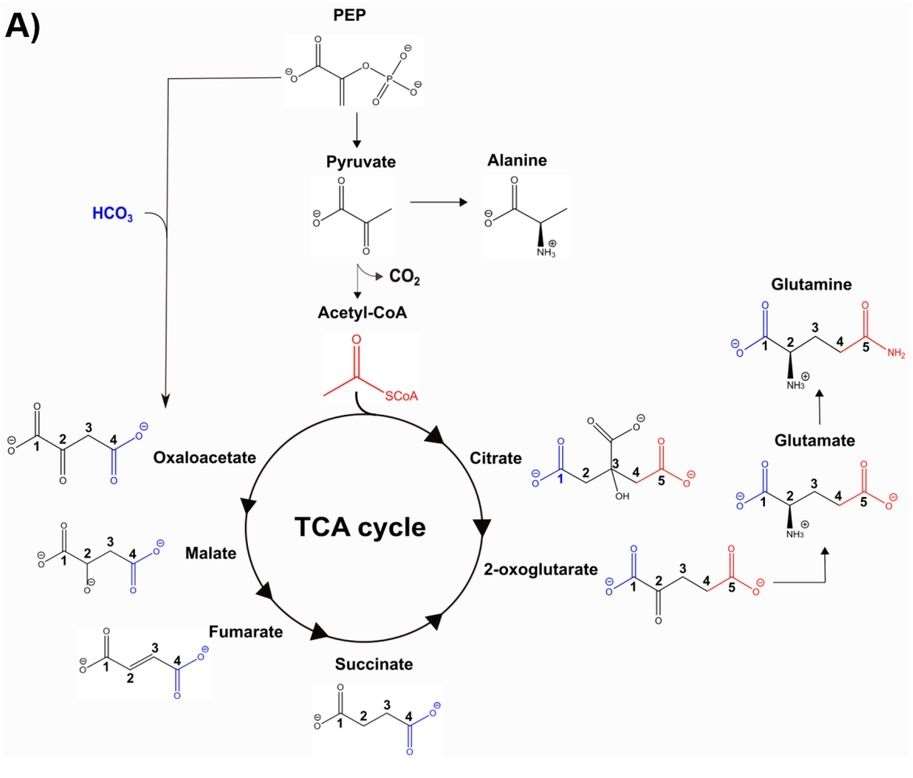Metabolic flux is a fundamental determinant of cellular physiology. Under steady-state conditions, metabolic flux is generally expressed as the specific rate of metabolite production and is the most important parameter in the metabolic pathway. Metabolic flux analysis (MFA) is an analytical method to determine the distribution of metabolic flux in the entire metabolic reaction network based on the stoichiometric relationships of individual reactions in the metabolic pathway and the data measured in experiments. Creative Proteomics can provide solutions for MFA of a range of mature cellular and tissue samples based on 13C or 15N stable isotope labeled metabolic precursors, such as D-Glucose (U-13C6), D-Glucose (1,2-13C2), D-Glucose (1-13C), L-Glutamine (13C5), L-Glutamine (amine-15N), L-Glutamine (1-13C), and L-Glutamine (5-13C) for central carbon metabolic pathways, fatty acid, nucleotide and amino acid metabolism.
Tricarboxylic acid (TCA) cycle
The TCA cycle is a common metabolic pathway in aerobic organisms and a major way for organisms to obtain energy. The TCA cycle is the central hub for the interchange of the three major organic compounds in the body, namely, sugars, fats and proteins, which are completely oxidized in this pathway.
 Fig. 1 Simplified diagram of the TCA cycle and associated pathways. (G. Daubermann, André, et al, 2021)
Fig. 1 Simplified diagram of the TCA cycle and associated pathways. (G. Daubermann, André, et al, 2021)
TCA cycle metabolic flux analysis service at Creative Proteomics
Nuclear magnetic resonance (NMR) enables the analysis of the 13C incorporation at a specific position in a molecule, which has been a critical advantage over MS approaches. While, the sensitivity of MS is much better than that of NMR, which allows the power of MS to analyze larger metabolic networks. Based on mass spectrometry (MS) and NMR-based 13C-MFA, we can provide detail information regarding the metabolic fluxes through the TCA cycle in animal cells and plants.
We can track changes in the following intermediate metabolites of the TAC pathway, but are not limited to:
- Citric acid
- Pyruvic acid
- Succinic acid
- L-malic acid
- Fumaric acid
Sample requirements
Cells, tissues, and microbial organisms
Cell number: 1×107 cells/sample
Biological replicates: 6-10 biological replicates
Detection platform
- GC-MS, LC-MS and NMR highly complementary detection platforms
- 13C-labeled Glucose carbon flux analysis
- 13C-labeled Glutamine carbon flux analysis
- 15N-labeled Glutamine nitrogen metabolic flux analysis
General project cycle
- Experimental testing: 50 natural days
- Data analysis: 7 natural days
Why choose us?
- 13C and 15N multi-marker tracers covering 100+ species of multi-pathway labeled metabolites
- Practical ultra-complete adherent cell and suspension cell metabolic flow collection scheme
- Packaged/customized metabolic flux assay and result interpretation integration service
- Experienced in large scale projects
MFA can help researchers gain insight into the various complex metabolic processes within cells and visually reveal the major active pathways within cells, the relative contribution of each pathway, and the characteristics of their distribution changes. If you have any questions or concerns, please feel free to contact us. Our goal is to exceed your expectations and provide you with the best service possible.
Reference
- G. Daubermann, André, et al. "Distinct metabolic flux modes through the tricarboxylic acid cycle in mesophyll and guard cells revealed by GC-MS-based 13C-positional isotopomer analysis." BioRxiv (2021): 2021-02.